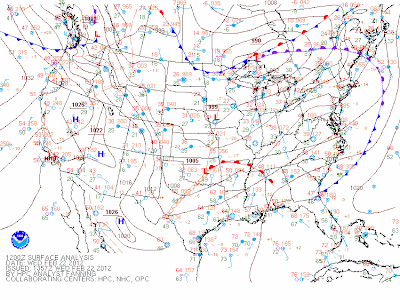I am closely watching the potential for some rare severe weather in the Midwest this upcoming Tuesday. Here's hour 114 of the 12z GFS.
Top left image: The top left image is 700mb wind speeds. The 700mb level is generally considered the area where 'jet streaks' (areas of strong winds within a jet stream) are found. Anyway, we see wind speeds of over to 70 knots, which equates to 80 MPH. 80 MPH is fairly strong for the 700mb level and can very well be conductive for severe weather. Seeing as this wind is flowing northeast, storms that form will be influenced and be moving northeast as well.
Top right image: The top right image is 300mb winds, which are the jet stream winds. In order for severe storms to form, there is usually a strong jet stream In this case, we have a jet stream of up to 130 knots present across a big swath of the Midwest, which equates to 150 MPH. 150 MPH is very strong and is nothing to mess with. To give you an idea of how strong it is, the jet stream present for the devastating April 27, 2011 tornado super outbreak was around 150 MPH.
Bottom left image: The bottom left image is 850mb winds. 850mb winds can detect how fast air flows, as the 850mb level is commonly watched for air temperatures at the surface. 850mb winds in this image show that wind speeds will be up to 70 knots+, which as shown above is over 80 MPH. Strong 850mb winds are usually pretty good for tornadic activity, so this will be something to watch.
Bottom right image: This is precipitation. In a couple images before this, the storms appear to form as a squall line turning into a cluster of storm cells. Multicelled storm clusters are typically the most dangerous and can be more conductive for tornadoes than squall lines. This will be something to closely watch.
We did pull up the best possible analogue picked out by the CIPS Analogue system, and here's what it has for severe weather reports from February 24, 2001.
As you can see, it was a pretty active day for severe weather, with 11 tornado reports, 99 wind reports and 59 hail reports. I can see this happening if it was moved north into the Midwest and Lower Great Lakes.
This could be a pretty serious event and will have to be watched.
Any questions can be asked below.
-Andrew
Top right image: The top right image is 300mb winds, which are the jet stream winds. In order for severe storms to form, there is usually a strong jet stream In this case, we have a jet stream of up to 130 knots present across a big swath of the Midwest, which equates to 150 MPH. 150 MPH is very strong and is nothing to mess with. To give you an idea of how strong it is, the jet stream present for the devastating April 27, 2011 tornado super outbreak was around 150 MPH.
Bottom left image: The bottom left image is 850mb winds. 850mb winds can detect how fast air flows, as the 850mb level is commonly watched for air temperatures at the surface. 850mb winds in this image show that wind speeds will be up to 70 knots+, which as shown above is over 80 MPH. Strong 850mb winds are usually pretty good for tornadic activity, so this will be something to watch.
Bottom right image: This is precipitation. In a couple images before this, the storms appear to form as a squall line turning into a cluster of storm cells. Multicelled storm clusters are typically the most dangerous and can be more conductive for tornadoes than squall lines. This will be something to closely watch.
We did pull up the best possible analogue picked out by the CIPS Analogue system, and here's what it has for severe weather reports from February 24, 2001.
As you can see, it was a pretty active day for severe weather, with 11 tornado reports, 99 wind reports and 59 hail reports. I can see this happening if it was moved north into the Midwest and Lower Great Lakes.
This could be a pretty serious event and will have to be watched.
Any questions can be asked below.
-Andrew







